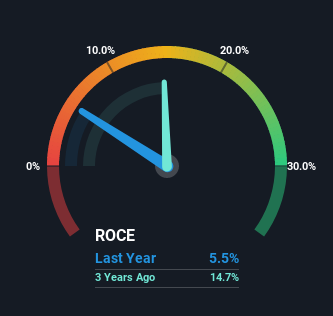
Ignoring the stock price of a company, what are the underlying trends that tell us a business is past the growth phase? Typically, we'll see the trend of both return on capital employed (ROCE) declining and this usually coincides with a decreasing amount of capital employed. Trends like this ultimately mean the business is reducing its investments and also earning less on what it has invested. In light of that, from a first glance at Aena S.M.E (BME:AENA), we've spotted some signs that it could be struggling, so let's investigate.
Return On Capital Employed (ROCE): What Is It?
If you haven't worked with ROCE before, it measures the 'return' (pre-tax profit) a company generates from capital employed in its business. To calculate this metric for Aena S.M.E, this is the formula:
Return on Capital Employed = Earnings Before Interest and Tax (EBIT) ÷ (Total Assets - Current Liabilities)
0.055 = €775m ÷ (€16b - €1.9b) (Based on the trailing twelve months to September 2022).
Thus, Aena S.M.E has an ROCE of 5.5%. Ultimately, that's a low return and it under-performs the Infrastructure industry average of 8.4%.
Check out our latest analysis for Aena S.M.E

In the above chart we have measured Aena S.M.E's prior ROCE against its prior performance, but the future is arguably more important. If you'd like, you can check out the forecasts from the analysts covering Aena S.M.E here for free.
How Are Returns Trending?
We are a bit worried about the trend of returns on capital at Aena S.M.E. Unfortunately the returns on capital have diminished from the 12% that they were earning five years ago. On top of that, it's worth noting that the amount of capital employed within the business has remained relatively steady. This combination can be indicative of a mature business that still has areas to deploy capital, but the returns received aren't as high due potentially to new competition or smaller margins. If these trends continue, we wouldn't expect Aena S.M.E to turn into a multi-bagger.
The Bottom Line On Aena S.M.E's ROCE
In summary, it's unfortunate that Aena S.M.E is generating lower returns from the same amount of capital. It should come as no surprise then that the stock has fallen 22% over the last five years, so it looks like investors are recognizing these changes. With underlying trends that aren't great in these areas, we'd consider looking elsewhere.
Like most companies, Aena S.M.E does come with some risks, and we've found 1 warning sign that you should be aware of.
For those who like to invest in solid companies, check out this free list of companies with solid balance sheets and high returns on equity.
New: Manage All Your Stock Portfolios in One Place
We've created the ultimate portfolio companion for stock investors, and it's free.
• Connect an unlimited number of Portfolios and see your total in one currency
• Be alerted to new Warning Signs or Risks via email or mobile
• Track the Fair Value of your stocks
Have feedback on this article? Concerned about the content? Get in touch with us directly. Alternatively, email editorial-team (at) simplywallst.com.
This article by Simply Wall St is general in nature. We provide commentary based on historical data and analyst forecasts only using an unbiased methodology and our articles are not intended to be financial advice. It does not constitute a recommendation to buy or sell any stock, and does not take account of your objectives, or your financial situation. We aim to bring you long-term focused analysis driven by fundamental data. Note that our analysis may not factor in the latest price-sensitive company announcements or qualitative material. Simply Wall St has no position in any stocks mentioned.
About BME:AENA
Aena S.M.E
Engages in the management of airports in Spain, Brazil, the United Kingdom, Mexico, and Colombia.
Solid track record with adequate balance sheet.
Similar Companies
Market Insights
Community Narratives



